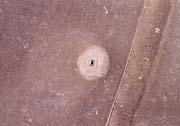Widespread use of thermoplastics began in the 1980s with the proliferation of single-ply roof systems, and they typically account for approximately 20 percent (on average) of the overall roofing market. Current industry statistics indicate that PVC and PVC blends have approximately 12 percent of the market share and TPOs, the most recent thermoplastic entry, make up 8 percent.
There are three common types of PVC sheets in the United States: sheets with polyester fabric reinforcement; sheets with non-woven fiberglass mat reinforcement; and sheets without reinforcing materials.
Early PVC membranes were manufactured without reinforcing materials and they experienced numerous problems. The most consistent problem was that the membrane was prone to "shattering" - or substantial splits. The problem became so apparent that in 1990, the National Roofing Contractors Association issued a bulletin to its member contractors alerting them of "the shattering of aged unreinforced PVC roof membranes." In 1992, the NRCA, in conjunction with SPRI, the association for sheet membrane and component suppliers, issued warnings to its members to avoid foot traffic on PVC roofs when the ambient outside temperature was below 50 degrees F. (Factory Mutual indicated that foot traffic should not be applied on these membranes when the temperature is below 60 degrees F.)
Fortunately, the PVC membranes currently produced have advanced from the early formulations. They have four basic ingredients: PVC resin, plasticizers, stabilizers and pigments. For proper performance all four of these ingredients must be properly balanced. The plasticizers that are currently used are significantly better than the initial type, resulting in less plasticizer loss from the membrane.
In addition, the manufacturers have recognized that a thin sheet loses more plasticizers than a thicker one. Thus mil thickness of the sheets has risen above the initial 32 mils. There are no current PVC membranes on the U.S. market that are less than the minimum allowed by ASTM D4434, which is 36 mils. The addition of reinforcements (polyester or fiberglass) to all membrane sheets has significantly reduced PVC shattering.
There are still concerns over the longevity of some reinforced PVC membranes. Identification of warning signs cannot be detected by visual observation. Laboratory analysis of the existing membrane should be conducted to determine the existing service life of the membrane.
On the plus side, PVC, like all thermoplastic materials, has performed well at seam adhesion because it can be heat welded. The seams are as strong, if not stronger, than the sheet itself. The seams at the tops and bottoms of the sheets are fused together with a homogenous bond that makes these areas stronger than the membrane. This characteristic makes thermoplastic materials a strong candidate for roof projects with multiple penetrations where there is a high ratio of lap-seam length to roof area.
Properly heat welded thermoplastic seams can provide the same fusion characters as welds in structural steel. This makes these typically vulnerable areas watertight for an extended period of time increasing the performance life of the roof system. Typical heat welding is completed with hot compressed air at temperatures that range from 500 to 600 degrees F. The primary advantage to contractors is that this process is quick, easy to learn, and reduces labor costs.

Patching Procedures
Distress signs of PVC membrane systems can be identified by signs of shrinkage or tightening of the membrane. Carefully inspect all flashing areas and seams for tightening and ballooning of the membrane. Openings or splits in the membrane and flashing areas should also be identified. To repair PVC, use membrane and flashing patch materials that are the same mil thickness, color and type as the existing materials. Bonding adhesives used for PVC membranes are produced with nitrile PVC base and solvents such as toluol and methyl ethyl ketone (MEK). Water-based bonding adhesives are also available that use acrylic latex as a base material.The NRCA and SPRI approve the following PVC membrane patch repair procedures. The following patching procedure is utilized in several repairs that require installing a patch to return the membrane to a watertight condition.
1. To promote thorough adhesion of a patch, it is essential to begin preparing the surface by removing debris, contaminants and ballast from the area of the membrane or flashing to be repaired. The area prepared should extend beyond the perimeter of the patch to provide an ample-sized clean work area. Scrub the repair area with a solution of detergent and water containing trisodium phosphate. Use warm water and a stiff-bristle brush to scrub the membrane. Rinse thoroughly with clean water and allow the membrane to dry. A rubber-bladed squeegee and clean, absorbent, lint-free cloths may be used to facilitate drying.
2. If the existing membrane surface is excessively contaminated or degraded, carefully enlarge the hole (make round) to allow the insertion of the new patch material under the existing membrane so that welding of a patch may be accomplished to the unexposed, less degraded side of the existing membrane. Cut a patch from a piece of new membrane material large enough to extend 4 inches beyond any part of the defect. Round all corners of the patch to limit peeling of square corners. Round the ends of the defect in the existing membrane.
3. Wipe the area of the existing membrane to receive the patch and the underside of the patch material with a clean, absorbent, lint-free cloth dampened with a solvent such as MEK or acetone. Do not pour the solvent directly on the membrane. Wipe the area clean with the solvent-dampened cloth. Allow the surface of the membrane and patch to air dry.
4. Weld the patch in place by using the three-step thermoplastic welding steps: Tack-weld the patch to the existing membrane by using a hot-air welder to weld the membrane sufficiently to hold the patch in place taking care to not wrinkle the patch material. Pre-weld the patch by inserting the hot-air nozzle under the patch and forming a continuous pre-weld approximately 2 inches from the edge of the patch. This pre-weld will prevent heat leakage during the final welding and is achieved by following the welder nozzle closely with a rubber-faced hand roller to provide pressure to adhere the back of the weld area. Final-weld the outer 2 inches by concentrating the heat on the remaining unadhered outer portion of the patch until the membrane and patch have reached the welding temperature. The hot-air welder should be moved quickly enough to avoid scorching the membrane, yet slowly enough to achieve a complete weld. Immediately behind the welder, roll the material to be bonded with the rubber-faced hand roller, rolling parallel to the outside edge of the welder nozzle and pressing firmly to adhere and mate the materials.
5. After the welded area has cooled, check seams for voids with a rounded-tip probe such as a screwdriver or awl with the tip rounded. Where patches are made with reinforced membrane material, seam seal the outer perimeter with seam sealant or caulking compatible with the membrane. This will prevent water from wicking through the exposed edge of the reinforcement. If the ballast was removed, redistribute the ballast over the exposed area.

Report Abusive Comment